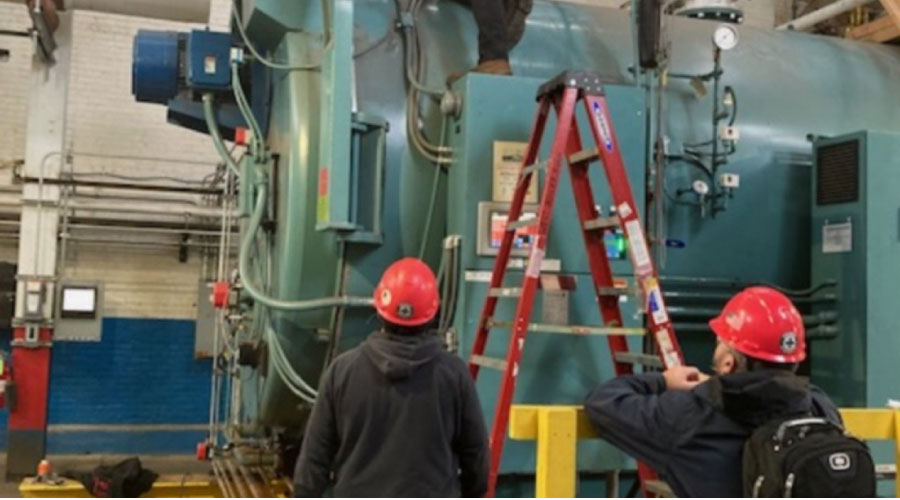Roof Coatings: Environmental Conditions Can Create Havoc
Environmental conditions can create havoc for waterborne acrylic and emulsion roof coatings for one simple reason: The concentration of water in the air changes with temperature, wind, and humidity, and since water is the solvent in these coatings, their cure rates are directly affected by the changing rate of evaporation.
The growing use of smart phones, which enable on-demand weather forecasts that include dew points, has proven helpful in assessing and confirming proper installation conditions in conjunction with manufacturer guidelines. Fall weather tends to be riskier than spring weather for applying coatings. Also, workers should suspend a coating application four-six hours before dew is expected.
Color is a crucial consideration in the curing process. Dark colors cure better in the cold, but they must be completely dry before a top coat is applied. In cool weather, wash-offs, freezes, and heavy dew all pose significant threats to proper film formation. Conversely, hot weather can create problems that include sun boiling and blistering that results from invisible traces of trapped water.
Product Substitutions
At first glance, elastomeric acrylic roof coatings might appear somewhat generic, even indistinguishable, but they often possess very specific and different performance features. Their appearance is in stark contrast to asphalt-cutback coatings and asphalt-emulsion coatings, which exhibit more consistent profiles among grades and brands. All acrylics provide a finished product with excellent ultraviolet (UV) resistance. Acrylic technology allows manufacturers to build a range of adhesion promoters and other properties directly into the polymer.
When a technical data sheet (TDS) or specification calls for a specific product, this guidance is critical. Most notable is adhesion. Some products bond very well to many roofing substrates, while others bond well to only one. Adhesion rarely is consistent among different suppliers, making substitutions especially risky with acrylics.
Other acrylic coating characteristics might include bleed blocking, high solvent resistance, and blocking plasticizer migration. All of these traits remain independent of how thick, resinous, or soft the product is. The point is that if a manufacturer says that managers should use a specific acrylic coating only for warranties over smooth modified bitumen, or that they should specify another coating for sprayed polyurethane foam (SPF) systems, these guidelines are based on basic technical features of the product. They are not pricing strategies.
Silicones typically are designed for application on SPF systems and have very long service lives if they achieve a proper bond. When applying them to other substrates, such as single-ply, built-up, and modified bitumen roofs, managers must be sure to ask about primers or conditioning. In general, the more a product resists weathering, the more it tends to have trouble bonding.
To overcome this issue, manufacturers use proprietary chemistry or systems. Silicones, such as acrylics, often use primers or basecoats that target a specific application. Managers should be sure installers follow specifications, and they should avoid last-minute substitutions.
In contrast, polyurethane coatings are classified mostly by cure mechanisms, which are readily observable. The cure mechanism explains the way coatings behave during application. Polyureas are fast curing and relatively moisture insensitive. Moisture cures are slow and very moisture sensitive, while two-component coatings are in the middle. Polyurethane coatings also differ in their backbone polymers, which determine post-cure performance. A discussion of aliphatic, aromatic, and the various backbones used in polyurethanes is a more in-depth topic, but managers should know these facts when using these more technical materials.
Asphaltic roof coatings — i.e., cutbacks and SEBS coatings — are generally simpler, more robust products. Many have been used for decades. Rules regarding the volatile organic compound (VOC) content of coatings have limited the use of these products, and these changes deserve attention in terms of application conditions. A low-VOC material might be less friendly in very hot or very cool weather. Asphalt products tend to vary along more quantitative lines — that is, the amount of asphalt, resin, or aluminum they contain.
Managers must be careful, though. Performance generally is linked to price, and while a value grade of a cut back might still work, in the long run, it is often more expensive to use the cheaper product. The cost of materials is rarely more than one-half the cost of any job, but the cost of materials is directly linked to the length of time the job will last.
Related Topics:














